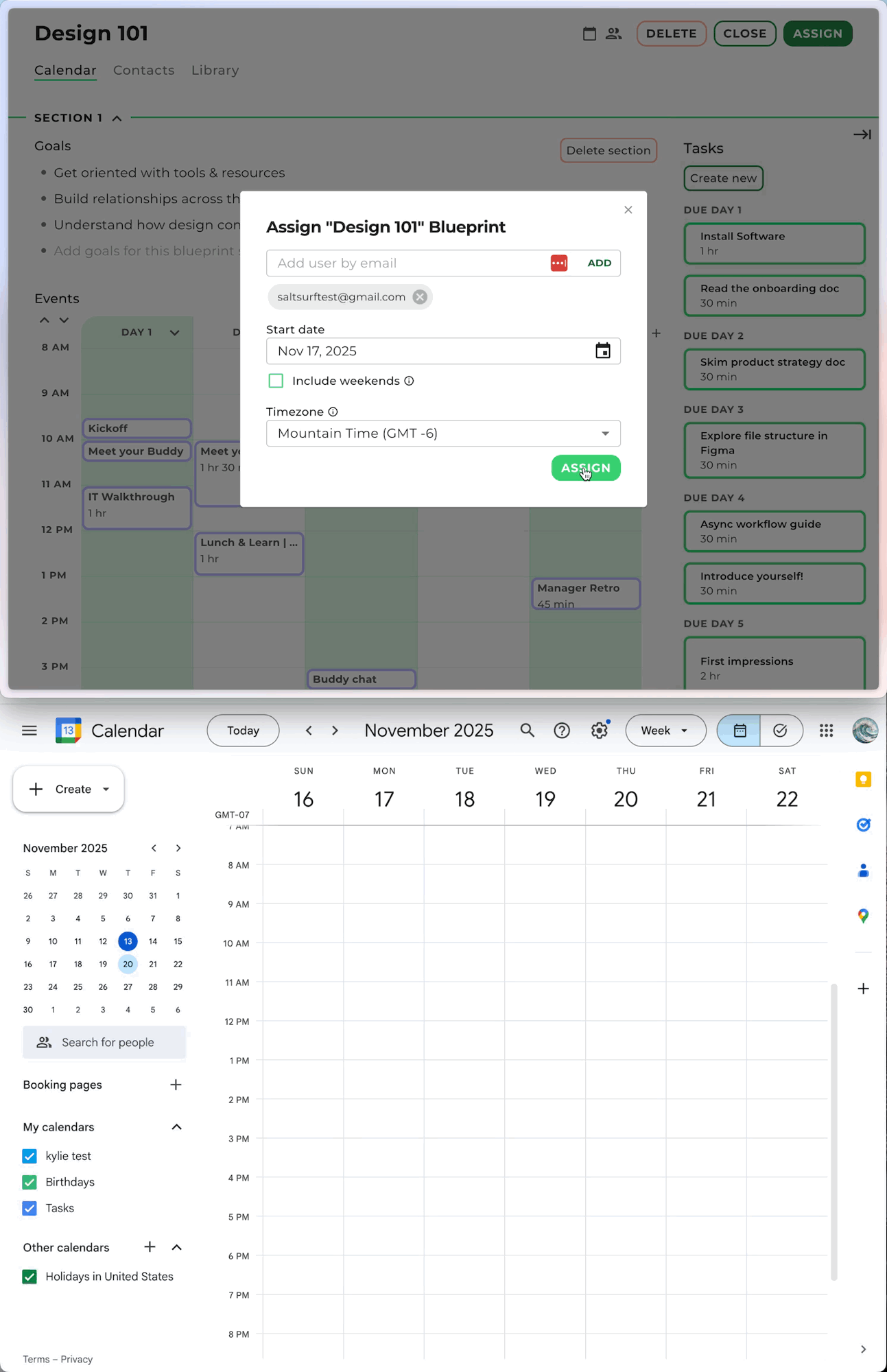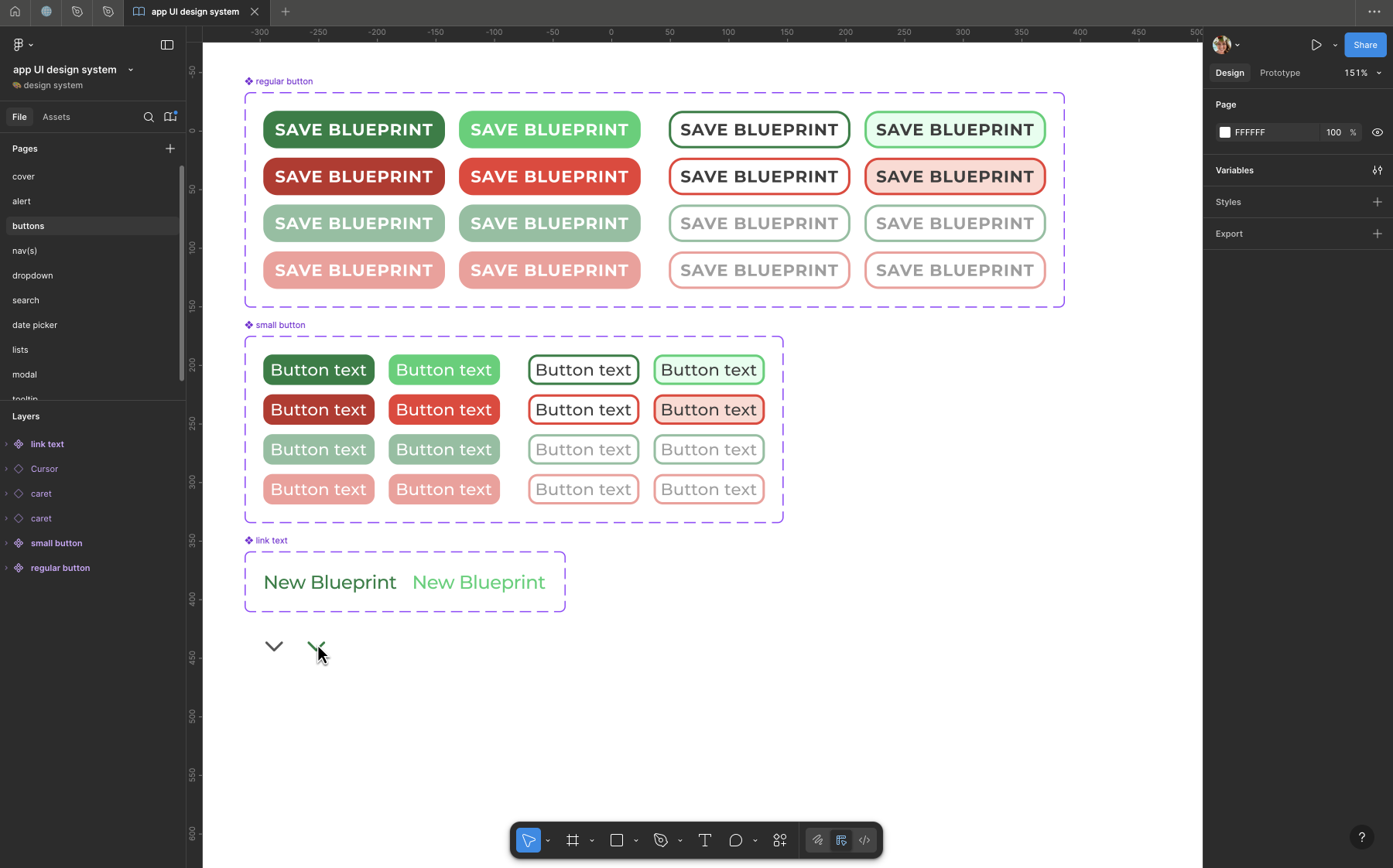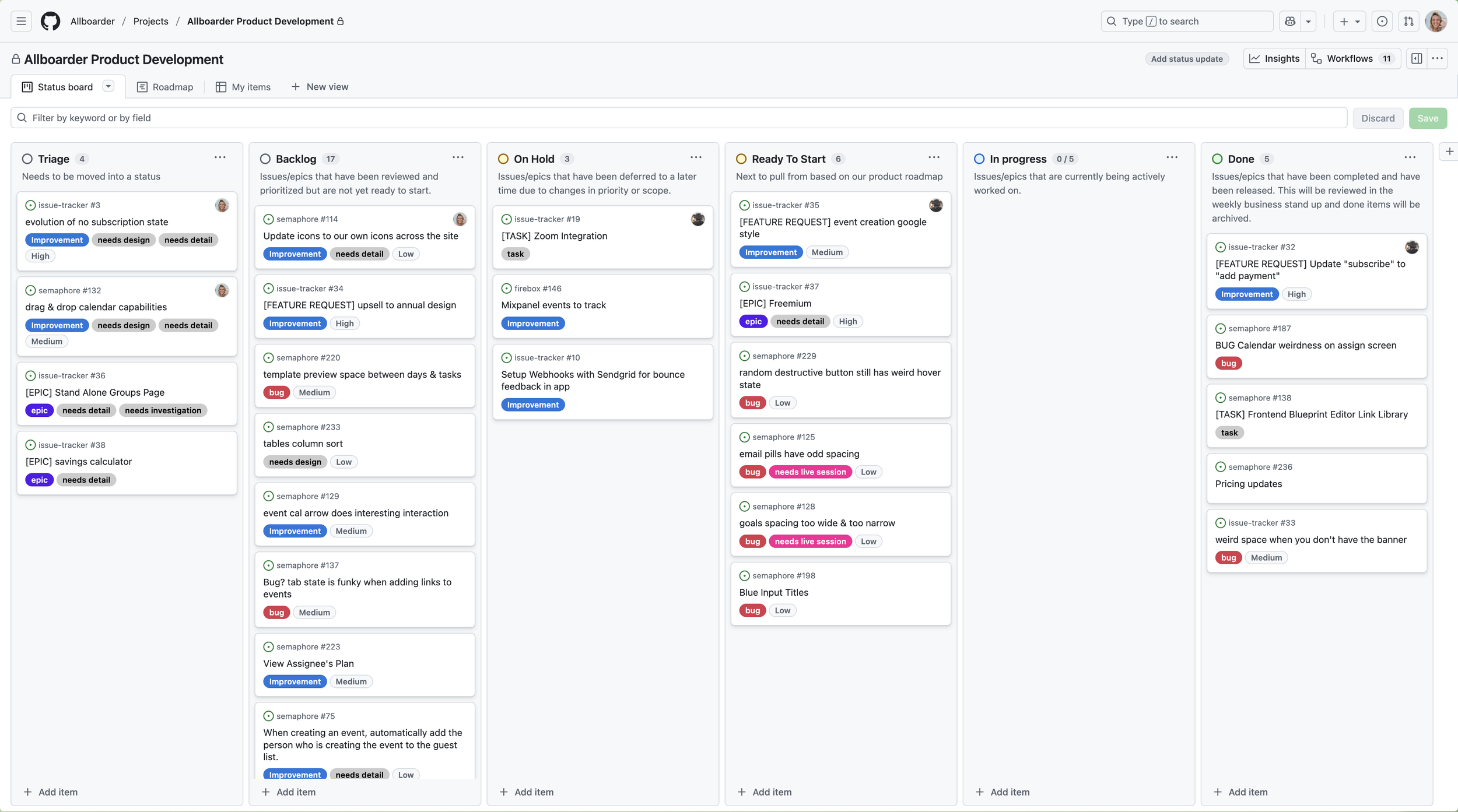Allboarder
Co-Founder & Head of Design • May 2023 - Dec 2025
Onboarding is too often rushed, inconsistent, and rebuilt from scratch. With Allboarder, we set out to change that by making onboarding feel intentional again. We designed a platform where teams could build and reuse structured onboarding flows that automated meetings, tasks, and resources — giving new hires clarity and giving managers their time back.
Over two years, I co-founded Allboarder and led design across product, brand, and marketing. I defined the core flows, built the design system, created the brand identity, and shaped the storytelling that carried across the product and marketing ecosystem. What began as a simple idea grew into a functioning platform with real users, a recognizable voice, and a vision for a more thoughtful first-week experience.
Overview
Problem
Teams struggled to deliver consistent onboarding because processes were scattered across tools and rebuilt for every new hire. Managers spent hours piecing together tasks, meetings, and resources, which led to rushed experiences and unclear expectations for new employees.
Solution
We created Allboarder to help teams build structured, reusable onboarding flows. The platform centralized tasks, meetings, and resources into simple templates that synced directly to calendars, making it easier to create a predictable and intentional first-week experience.
Outcome
Over two years, we built a functioning product, a cohesive brand, and an early user base that relied on Allboarder to save time and deliver more consistent onboarding. Even with limited development resources, the platform validated the need for structured onboarding in a space that often defaults to scattered documents and manual setup.
My role
As co-founder and Head of Design, I led Allboarder’s vision from concept to launch and shaped the product, brand, and experience at every stage. I partnered closely with my co-founder on the roadmap, collaborated with developers to bring designs to life, and created the structure that kept us moving. My work spanned onboarding teammates, establishing company processes, and bringing clarity to the messiness of early-stage building. I balanced vision, craft, and execution, ensuring our design principles showed up not only in the product, but in how we operated as a team.
What is Allboarder?
Allboarder is an onboarding platform that helps teams deliver a consistent, complete experience for every new hire. The product allows managers and HR teams to build repeatable onboarding flows that organize meetings, tasks, and resources in one place, creating a more intentional and structured first week.
0 → 1
Building Allboarder was a true 0→1 experience. What started as a simple idea quickly turned into a working product as our team moved from early concepts to an MVP in just a few months. I worked closely with engineering to define the core flows, shape the interaction patterns, and translate the vision into something teams could use immediately.
An early milestone came when we earned 3rd place at a regional startup showcase in early 2024. We were still in the earliest stages of shaping the product, but judges consistently highlighted how clearly the problem was defined and how strong our design direction already felt. That moment gave us external validation at a time when we were building on early research, and it reinforced that Allboarder was solving a real, recognized need.
With limited and shifting development support, I prioritized clarity and momentum. We focused on the essentials, validated assumptions quickly, and designed systems that could scale even as we moved fast. Seeing our first users adopt the product was the moment it felt real. Managers were able to recreate their onboarding processes in minutes instead of hours, which confirmed that our approach resonated.
This early phase set the tone for how we built the company: scrappy, intentional, collaborative, and grounded in the belief that onboarding deserves more structure and care than most teams have the capacity to create on their own.
Early brainstorming
A few slides from our pitch deck
Design Highlights
The product itself evolved over time, but three design decisions shaped the core experience. These highlights represent the foundation of how Allboarder worked and the principles that guided the product forward.
Blueprint Creation
Blueprints became the core of Allboarder’s value. Early user interviews made it clear that managers were spending hours rebuilding the same onboarding steps for every new hire. My goal was to turn that repetitive work into a simple, reusable system.
I designed a creation flow where managers could outline meetings, tasks, and resources in a clean, structured editor. Each step intentionally reduced cognitive load: clear hierarchy, predictable fields, and optional details that didn’t overwhelm the setup process. Once a Blueprint was ready, managers could assign it with one click.
The moment those events appeared instantly on a calendar was the breakthrough. Users described it as “magic” because it compressed hours of administrative work into seconds. This was the first feature that made Allboarder feel alive, and it validated the larger vision for automated onboarding.




A snapshot of our design system
Design System
With a small team and shifting development support, consistency became essential. I built a scalable design system that unified our typography, spacing, interaction patterns, and visual hierarchy. It gave us a clear foundation to build from and kept the product cohesive even as new contributors joined.
I prioritized accessibility and predictability so the product felt calm and intuitive. Establishing contrast rules, simplified patterns, and consistent navigation reduced cognitive load for both managers and new hires. This system became the backbone of the product and allowed us to move quickly without sacrificing clarity or quality.
Conflict Resolution
As teams began assigning Blueprints, a consistent challenge surfaced. Automated onboarding flows sometimes created meetings that conflicted with the calendars of existing teammates responsible for running those sessions. Because no tool handled this gracefully, Blueprint assigners had no easy way to see whether the people involved in onboarding were actually available.
I explored a conflict resolution experience designed to surface these overlaps early and guide managers toward simple fixes. Inspired by Google’s “Find a time” patterns, the concept highlighted conflicts clearly, explained what was happening in plain language, and suggested alternative meeting windows based on teammate availability. The goal was to build trust in automation by giving Blueprint assigners transparency and simple, low-effort adjustments.
Although the feature was fully designed, we never had the opportunity to develop it, as we determined that current market demand was not strong enough due to cultural shifts in tech before work began. However, the exploration shaped our long-term vision for Allboarder and showed how the platform could evolve from static templates into a more intelligent scheduling system that adapts to real-world team availability.



Brand & Marketing Identity
When we committed to building Allboarder, we needed a brand that could stretch across everything: product, marketing, social, and even the internal culture we were creating. I started by exploring a range of visual directions through moodboards, testing what felt aligned and what did not. The overly “professional” direction leaned too cold and too tech-bro, which was the opposite of what we wanted. We envisioned something women-led, bold, and confident, a brand that communicated clarity and care without losing personality.
From those explorations, the “Bold Feminine” direction emerged as the clear fit. It felt confident, modern, and refreshingly human. I built the foundation of the brand from there, developing our color palette, typography, illustration style, and core marketing layouts. I created early landing page concepts, social templates, and a complementary app palette to ensure the product and marketing felt like the same family. These assets set the tone for every touchpoint that followed, giving Allboarder a clear and cohesive identity long before we launched.
One of the more unexpected inspirations came from a simple banana illustration pinned in an early moodboard. It felt playful, warm, and metaphorically fitting: onboarding is joining the bunch. That idea became a subtle motif across our system, showing up in shapes, textures, and illustration accents. Over time, the marketing site and the app started to feel like two parts of the same whole, united through tone, spacing, and visual behavior. We consistently heard from peers and early users that the brand felt fresh, cohesive, and instantly recognizable as Allboarder.
The chosen moodboard & initial design application
A snapshot of our kanban board
Leadership
Leadership at Allboarder meant learning while building. I advocated early for the tools and structure that helped the team communicate clearly, including daily Kanban reviews, consistent standups, and open channels for questions and collaboration. As new developers and contractors joined, I created onboarding processes that helped them understand the product quickly and contribute confidently.
When conflict surfaced, I handled it directly and calmly. One example was addressing disrespectful communication from a teammate. I prepared talking points, pulled him aside, and had a clear conversation about how we would work together moving forward. It reshaped the dynamic and reinforced the culture we wanted to build.
I also stepped into the inevitable gaps that come with early-stage building, spanning marketing, operations, content, and product strategy to keep us moving. Leadership here was not about authority. It was about bringing clarity to ambiguity, supporting progress, and helping the team do their best work.
Entrepreneurship
Building Allboarder required a level of adaptability that shaped me as both a designer and a founder. We were building in a challenging market and often without consistent development support, which meant every decision had to be thoughtful, realistic, and grounded in what would create the most value for the people using our product. I learned how to maintain momentum even when the path forward was unclear.
Wearing Every Hat
My role extended far beyond UX. I learned how to navigate sales conversations, refined how we told our story in demos, and built confidence in positioning the product to different audiences. I researched marketing best practices, introduced new campaign ideas, and built the foundations of our content and social presence. I created company documentation, helped structure our internal workflows, and set the stage for healthy collaboration as our team grew and shifted.
These responsibilities weren’t things I originally expected to own, but they became integral to how Allboarder moved forward. They gave me a broader understanding of how product, brand, marketing, and operations work together, and they strengthened my ability to build holistically across the business.
Looking Back
Even with limited resources, we built something real: a functioning platform, a cohesive brand, and a product that managers relied on to save time and deliver more consistent onboarding. The experience strengthened my instincts as a founder and deepened my belief that thoughtful design can influence not only how people work, but how teams operate and communicate.
Where Allboarder Is Today
Allboarder reached the end of its runway in 2025 as the market shifted and investment in people-focused tools continued to decline. While we made the decision to sunset the product, the platform remained fully functional through its final months, and early users continued to rely on it for structured onboarding until the very end.
In many ways, Allboarder was successful. We built a complete product with a clear brand, a functioning app, an engaged user base, and a vision that resonated far beyond our team size. We created something thoughtful, intentional, and genuinely helpful in a space that often feels overwhelming for both managers and new hires.
Sunsetting the company was not a sign that the idea lacked value. It was the outcome of timing, resources, and a market that never swung back toward investing in HR and people-first tools. Even so, the experience shaped me deeply as a founder and designer. I learned how to navigate ambiguity, make strategic decisions, build systems from scratch, and carry an idea from concept to a fully realized product.
Allboarder represents a chapter I am proud of: we created something real, meaningful, and uniquely ours. And the lessons I gained from this journey continue to influence how I build, lead, and design today.












